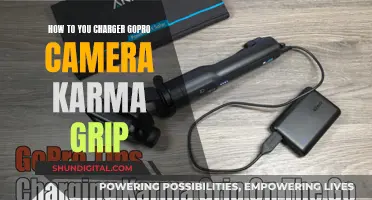
If you've ever opened the battery compartment of your camera to find a white, crusty substance encrusting the battery terminals and contacts, you're not alone. This is a common issue caused by battery corrosion, which can happen when batteries are left in the camera for an extended period. The good news is that you can often clean the corrosion and restore your camera to working order. In this article, we will discuss the steps to safely and effectively clean battery corrosion from your camera and prevent it from happening again.
| Characteristics | Values |
|---|---|
| Protective gear | Gloves, safety goggles/glasses, long-sleeved clothing |
| Tools | Cotton swabs, toothbrush, toothpick, fine sandpaper, pencil eraser, microfiber cloth, compressed gas, flashlight |
| Chemicals | White vinegar, lemon juice, baking soda, water, isopropyl alcohol |
| Cleaning process | Identify corrosion, apply vinegar/lemon juice, scrub, scrape, apply isopropyl alcohol, dry |
| Battery disposal | Check local regulations, recycle when possible |
What You'll Learn

Wear protective gear: gloves and safety glasses
When dealing with battery acid corrosion, it is important to take the necessary precautions to protect yourself from harmful chemicals. Before you begin the cleaning process, make sure you have the right protective gear. Gloves and safety glasses are essential.
Gloves will protect your hands from coming into direct contact with the corrosive substances. Look for heavy-duty gloves or nitrile gloves, as suggested by experts. This will create a barrier between your skin and the corrosive materials, ensuring that you do not accidentally irritate your skin or, worse, burn yourself.
Safety glasses will shield your eyes from any debris or chemicals that may be flicked or splashed towards your face during the cleaning process. This is especially important when dealing with corrosive substances, as they can cause serious eye damage. Any type of eyeglasses can be used as protection, but if possible, opt for safety goggles or glasses with side shields for maximum protection.
In addition to gloves and safety glasses, it is also recommended to wear a face mask to prevent the inhalation of corrosive particles or fumes. A mask will also protect your nose and mouth from any accidental splashes of corrosive substances. Furthermore, ensure you are working in a well-ventilated area to avoid inhaling harmful fumes.
By taking these precautions and donning the appropriate protective gear, you can safely and effectively clean battery acid corrosion from your camera or any other electronic device.
Camera Batteries: Do They Die?
You may want to see also

Remove and dispose of corroded batteries
Before removing the corroded batteries, it is important to protect yourself and your workspace. Cover your work surface with newspaper and put on protective gear, such as rubber or latex gloves, safety glasses, and even a mask. Keep the area well-ventilated.
Now, carefully take the corroded batteries out of the battery compartment. Make sure to keep the camera upright to prevent any residue from dripping inside. Place the removed batteries in a plastic bag or a cardboard box. Do not throw them into the trash or recycling bin. Instead, dispose of them at a hazardous waste collection site or a recycling facility. In the US, you can refer to the EPA website or contact your local sanitation department to find the nearest drop-off location. Remember to tape the battery terminals or put each battery in an individual plastic bag to avoid the risk of sparks during storage or transportation.
The disposal guidelines vary based on your location and the type of battery. For instance, in California, all batteries are considered hazardous waste and must be taken to a designated collection event or centre. Single-use batteries, such as alkaline and zinc-carbon batteries, can usually be disposed of in the regular trash in most places, but check with local regulations to see if recycling programs are available. Rechargeable batteries, on the other hand, must be taken to a recycling centre or hazardous waste collection site.
Charging GH5 Batteries: In-Camera Method
You may want to see also

Clean corrosion with vinegar or lemon juice
To clean corrosion with vinegar or lemon juice, you can follow a few simple steps. First, open the battery door and use a flashlight to identify the areas affected by corrosion. It usually resembles rust. Then, apply some isopropyl alcohol to a cotton swab and gently clean these areas. You can also use a toothbrush for larger, more corroded areas.
Next, add a small amount of baking soda to the affected areas. Then, apply vinegar to a clean cotton swab and drip it onto the baking soda. Be careful not to use too much vinegar, as it could damage the internals of your camera. The combination of baking soda and vinegar is effective at creating enough oxygen to remove corrosion.
After applying the vinegar and baking soda mixture, use a clean towel to wipe down the area. You can then give it another pass with isopropyl alcohol and let it dry. Repeat the process if necessary.
Lemon juice can also be used in a similar manner to vinegar. Create a mixture of equal parts salt and lemon juice. Apply this mixture to the rusty areas using an abrasive pad or steel wool in small, circular motions until the entire surface is coated. Let the lemon juice mixture sit for 30 minutes to 2 hours. Then, use the abrasive pad again to knock any loose rust free. Rinse and dry the item.
It is important to note that vinegar and lemon juice are both acidic substances, so it is recommended to wear gloves and protect your skin when using them. Additionally, do not soak the camera or any electronic device in vinegar or lemon juice, as it could cause further damage.
Wireless Surveillance Cameras: How Long Do Batteries Really Last?
You may want to see also

Wash surfaces with isopropyl alcohol
To wash surfaces with isopropyl alcohol, you'll want to use a high-strength (91% or higher) isopropyl alcohol solution. Use a foam or regular cotton swab (Q-tip) to apply the alcohol to the affected areas. You can be gentle but thorough in your cleaning. If there are springs in the battery compartment, note that they might be a bit tougher to clean, but they aren't too important to worry about.
After removing as much of the corrosion as you can with the isopropyl alcohol, you can add a bit of baking soda to the affected areas. Then, apply some vinegar to a new, clean cotton swab and drip it onto the baking soda. Be careful not to use too much vinegar, or you might destroy the internals of the camera.
Once you've applied the vinegar, clean the area with a towel. Then, give it another pass with isopropyl alcohol. Let it dry, gently patting it down. Within a few hours, it should all be dry. If you're not satisfied with the result, you can always repeat the process.
Isopropyl alcohol is highly recommended by camera cleaning crews worldwide and is a great tool for cleaning electronics like cameras, lenses, etc.
Vivint's Outdoor Camera: Battery-Powered Wireless Security
You may want to see also

Let the device dry completely
Once you have cleaned the affected areas of your camera with isopropyl alcohol, baking soda, and vinegar, it is important to let the device dry completely before installing fresh batteries and powering on the camera.
After cleaning the corroded areas, use a clean, dry microfiber cloth to wipe down the battery compartment and affected areas. You can also use a pencil eraser to polish the contacts and other small sections. If there is debris that is hard to dislodge, use compressed gas to blow it away.
Let the camera sit for a few hours to ensure any remaining liquid evaporates and that the device is completely dry. It is important to be patient during this step, as turning on the camera before it is completely dry could cause further damage or other problems.
If you are not satisfied with the cleaning job, you can repeat the process. However, make sure to let the camera dry completely after each cleaning attempt.
After the camera is dry, you can install fresh batteries and power up the device. If the camera still does not work, the problem may be beyond the battery corrosion, and you may need to seek professional help or consider purchasing a new camera.
Charging Vintage Camera Gear: 1990s Battery Revival
You may want to see also
Frequently asked questions
You should be able to clean the corrosion and unstick the compartment with a few household items. First, protect yourself with gloves and goggles, as the acid can be caustic. Remove the batteries and use a cotton swab to wipe away any debris. Apply a small amount of vinegar or lemon juice to a new cotton swab and clean the compartment. Then, dry the compartment with a clean swab and leave it open to air dry before inserting new batteries.
When batteries are left in a device for a long time, they slowly discharge and a build-up of gas leaks out in the form of battery acid. This acid then reacts with the carbon dioxide in the air to form a white, crystalline substance known as potassium carbonate.
When you open the battery compartment, you will likely see a white, flaky, or crusty substance encrusting the battery terminals and contacts.
It is important to protect yourself when handling corroded batteries. Wear protective gloves and eye protection, such as safety goggles or glasses, to prevent the corrosive chemicals from coming into contact with your skin or eyes. You may also want to wear long-sleeved clothing for added protection.
In addition to protective gear, you will need cotton swabs, white vinegar or lemon juice, and rubbing alcohol or isopropyl alcohol. A pencil eraser, microfiber cloth, and compressed gas can also be useful for cleaning and polishing the contacts.







